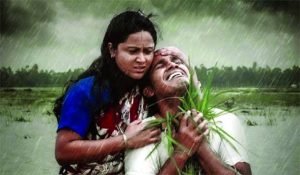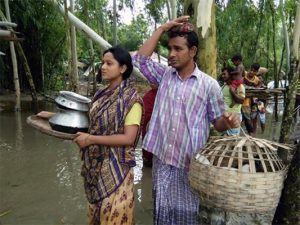Bangladeshi cinema presented itself at the 21st Dhaka Film Festival with a strong vintage reflection, from which Khandaker Sumon’s Saatao – Memories of Gloomy Monsoons especially convinced with subtle political criticism and subversive poetry. Axel Timo Purr explains why the film made such a poignant impact.
“Take my Saree to wipe out your tears…” ~ Wedding song in Saatao
“We are one of the others.” ~ Marshall Sahlins, 1972
Hearing even in the cinema hall the passionate demonstrations and counter-demonstrations for fair elections at the end of this year, it has already become clear that Bangladesh is facing hard times this year. Such hard times that actually begun a year ago, as the British newspaper The Guardian also noted a few days ago, after the first journalists and opposition members such as the cartoonist Ahmed Kabir Kishore had already left the country following torture, prison sentences and the first deaths. But this is also because media and artists have now completely internalized state censorship, not only because of the increasingly oppressive policies of the current government, but also because for years a fanatical Islamic minority has been responsible for murders of independent bloggers and journalists.
Therefore, it is perhaps not too surprising that a remarkable proportion of the Bengali films at this year’s 21st Dhaka Film Festival dealt with historical material that repeatedly recurs to the unspeakable genocide of the then West Pakistan against East Pakistanis, i.e., today’s Bangladesh in 1971, and the struggle for independence, sometimes with impressive creative furor, such as Raihan Rafi’s Damal, which turns a soccer film into a war film that is as surprising as it is electrifying.
All the more credit goes to Khandaker Sumon’s Saatao – Memories of Gloomy Monsoons for leaving the important history of the country to the past for once and concentrating on the equally important present, to which what has happened so often before, such as in Chinua Achebe’s novel “Things Fall Apart” (1958) – the old dies and the new is barely enough to live on.
But this is not at all obvious at the beginning of Saatao – to be translated in the Rangpur dialect of Bengali as the seven inevitable days of a week. For there the suggestive camera work of Sozal Hossain, Ihtesham Ahmed and Khandaker Sumon, which is always looking for new shots, still shows the old, which seems to be in balance, for example in a great opening scene a traditional boat race, which glides into a traditional wedding and already here it becomes clear that every transformation into a new state, even a wedding, always means pain.
The bride, Aynun (Aynun Putul), tries to console her difficult parting from her family with a newly purchased cow that gives her the emotional bond that her husband cannot provide, as Fazlul (Fazlul Haque), despite all sincere closeness, must farm the rice fields and leave Aynun alone. Khandaker Sumon, who is also responsible for the screenplay, depicts this everyday life and with his two main actors, who have hardly attracted attention in Bengali cinema so far, and amateur actors who perform souvrän, with a dense, lyrical look and an original, formally impressive visual aesthetic that says more than the sparse dialogues of the protagonists could express; flowers, bees, birds, are cut against the hardships of life, and when the cow suddenly dies and the woman plunges into a depressive crisis after a miscarriage, Sumon finds striking images for this as well, using surprising cuts from the living cow to its skeletal remains to show the merciless transience of life.
If these stories, as well as the hauntingly filmed rituals of collective fishing and the similarly group-focused making of seasonal rice cakes are moments also familiar from European peasant tradition – and also vividly described from Władysław Reymont’s “The Peasants” (1904-09) to Knut Hamsun’s “Blessing of the Earth” (1917) – something entirely new sets in halfway through Sumon’s film, and the balance of beauty and cruelty gets out of sync.
Although the woman regains her composure with a new cow in the household, with which she builds up an even more intensive, basically already a mother-child relationship, it suddenly becomes clear through the loan that has become necessary as a result that nothing is actually right here anymore. For what would have been unthinkable twenty years ago in the Bengali countryside suddenly becomes manifest – corruption determines success and survival here as well, not unlike in the city and in contemporary politics. Sumon shows these abysses subtly, almost incidentally, he cares all the more about the consequences for his heroes: We see the first young farmers migrate to the sweat stores of Dhaka and then also hear about the tragedies, for example of a collapsed factory, in which former farmers from the countryside also perished, instead of life and success death returns to the countryside. And then there is nature. Here, too, things are no longer right, the world is out of sync, the rivers are first dried up, then flooded and the harvest destroyed.
Sumon finds images of violent beauty for this, and playfully links, with powerful poetry, economic and climatic globalization with the people in the countryside, he brings the world to the country and the country to the world. These are images and narratives that, on the one hand, concretely tell of a world that is falling apart, which is also our world, but which then also remains at home and immediately tells another tragedy, that of the infertility of Aynun, which has almost symbolic power and could stand for Bangladesh itself, even more so when the film takes a final, subtle swipe at the broken structures of the indigenous society, and – courageously and sovereignly – even portrays that religion, Islam, on a feast day like Eid ul-Adha, is no more than the country’s current politics: An entity marked by greed, which does not even hold sacred the compassion for one’s neighbor that is so important during Eid ul-Adha.
Once again, Sumon surprises us by leaving the countryside for its end, panning to Dhaka, just declared the most polluted city in the world to show the seasonal work of rickshaw pullers and even the last bond of all, the private, threatening to implode. Sumon sensibly decides against too unequivocal a condemnation here, offering up the core relationship, family and love as the last, reliable spark of hope. That, after all, would be enough for a new beginning, as Marshall Sahlins described it in his 1972 book “ Stone Age Economics” (republished 2003, 2017).
This makes Saatao – Memories of Gloomy Monsoons one of those rare, universal films that explains the big via the small, that can be understood not only in Bangladesh, but also forcefully explains to every Western moviegoer how our world is made up and how we in the West are actually the Bengali farmers of tomorrow.
Axel Timo Purr
Edited by Steven Yates
© FIPRESCI 2023


